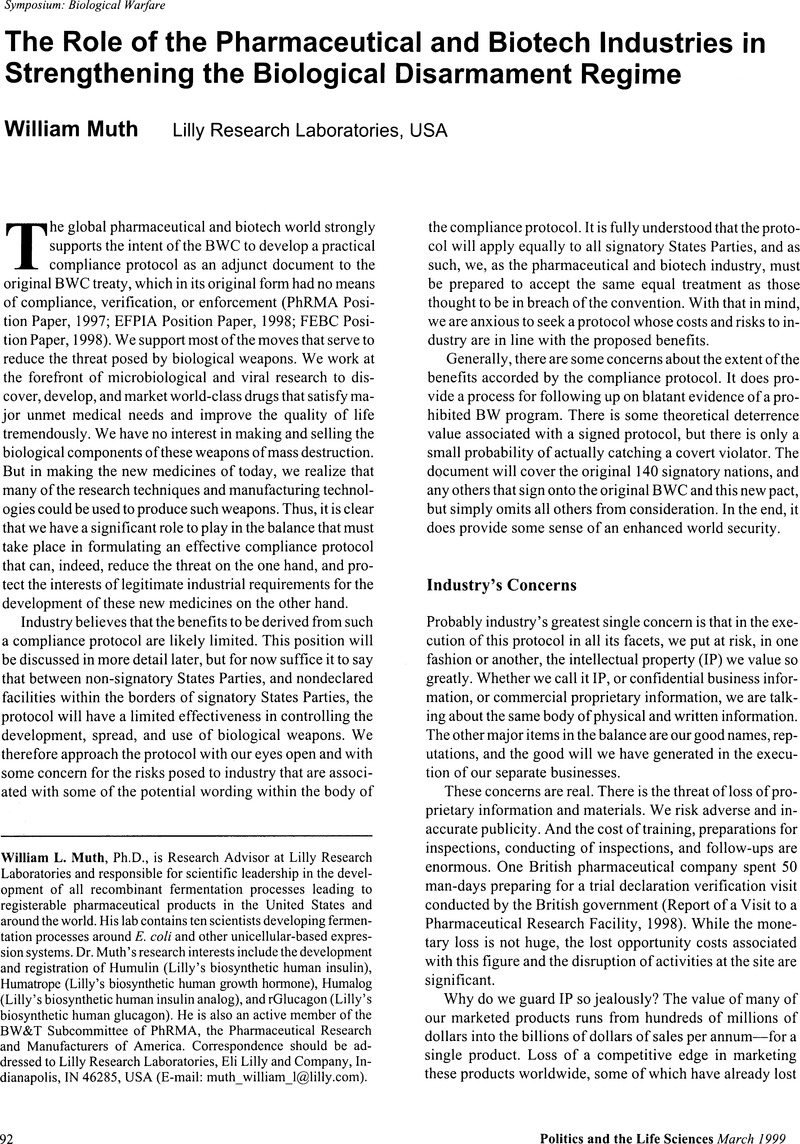Article contents
The Role of the Pharmaceutical and Biotech Industries in Strengthening the Biological Disarmament Regime
Published online by Cambridge University Press: 17 May 2016
Abstract
An abstract is not available for this content so a preview has been provided. Please use the Get access link above for information on how to access this content.

- Type
- Symposium: Biological Warfare
- Information
- Copyright
- Copyright © Association for Politics and the Life Sciences
References
Discussion paper of the United States of America: Proposed Elements of Clarification Visits (1998). July.Google Scholar
EFPIA Position Paper: The Position of the European Federation of Pharmaceutical Industries and Associations (EFPIA) (1998). Circular 8092, July 28.Google Scholar
FEBC Position Paper: Forum for European Bioindustry Coordination (FEBC) Position on a Compliance Protocol to the BTWC (1998). Draft, June 30.Google Scholar
Morse, S.S. (1997). “Technologies for Biological Sampling and Analysis.” In Tucker, J.B., (ed.), The Utility of Sampling and Analysis for Compliance Monitoring of the Biological Weapons Convention. Monterey, CA: Monterey Institute of International Studies.Google Scholar
Muth, W.L. (1997). “Industry Views on Sampling and Analysis.” In Tucker, J.B., (ed.), The Utility of Sampling and Analysis for Compliance Monitoring of the Biological Weapons Convention. Monterey, CA: Monterey Institute of International Studies.Google Scholar
PhRMA Position Paper: PhRMA Position on a Compliance Protocol to the Biological Weapons Convention (1997). January 9.Google Scholar
Report of a Visit to a Pharmaceutical Research Facility (1998). Working paper submitted by the United Kingdom of Great Britain and Northern Ireland. BWC/AD HOC Group/WP.258.Google Scholar
Woollett, G. (1998). “Biological Weapons Proliferation: Reasons for Concern, Courses of Action.” Henry L. Stimson Center Report No. 24., January.Google Scholar
Zabriskie, D. (1998). “Strengthening the Biological Weapons Convention and Implications on the Pharmaceutical and Biotechnology Industry.” Current Opinion in Biotechnology 9:312–11.Google Scholar
Zelicoff, A.P. (1995). “The Biological Weapons Convention: What Is the Role of Sample Collection in a Legally-Binding Regime?” Politics and the Life Sciences 14:79–84.Google Scholar
- 3
- Cited by




